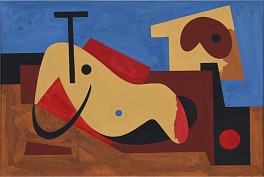BIOGRAPHY

American (1900-1973)
Considered on of the earliest American abstractionists, Carl Holty was a bridge between pre-war European modernism and the American art scene during that period, especially in terms of the development of an abstract aesthetic in the U.S. His friend and fellow artist George L. K. Morris recalled his first encounter with Holty, at the 1936 meeting in New York at which the American Abstract Artists group was founded. During the ’30s, abstract art had a hard row to hoe in this country, due to the dominance of social realism and the more figurative aspects of Surrealism. Those artists who wanted to work in a purely abstract mode felt the need to band together for mutual support and to promote their ideas. Morris later wrote, “It soon became apparent that Holty provided just what the organization needed. Although complete as an artist, he was by nature pragmatic—he had no patience with nebulous comments. In other respects he was also unique; many of the New York abstractionists of that period—for good reason—were suffused with perpetual Weltschmerz. Not Carl Holty, who seemed possessed of a native buoyancy. I never saw him shy or retiring; he always had a way of countering negativism with some pertinent anecdote.”
Born in Milwaukee, first became exposed to modernism in 1926 when he went to Munich to study with Hans Hofmann. While studying with Hofmann, Holty mastered a precise, structured style, based on the reduction of forms and elements of space to geometric shapes, that remained dominant in his work until the 1950s. In 1930, he moved to Paris. There he befriended Robert Delaunay, whose Orphic school espoused an intensely color-based type of abstraction. Through Delaunay, Holty was invited to join an international cenacle called the Abstraction-Creation group, whose members included such luminaries as Theo van Doesburg, Jean Hélion, Albert Gleizes, and Jean Arp. The only other American in the group was Alexander Calder. The influences from van Doesburg and Mondrian’s Neoplasticism and other “non-objective” currents absorbed in Paris led to Holty’s leaving virtually all references to nature and the external world behind by the mid-1930s.
In 1936 Holty was back in New York, which would be his base from then on. It was in that year that he co-founded American Abstract Artists; as an emissary from the avant-garde of Europe and an accomplished practitioner of hard-edged geometric abstraction, he naturally had the standing to do so. His fellow members included Morris, Albert E. Gallatin, Josef Albers, Burgoyne Diller, Ibram Lassaw, Giorgio Cavallon, and Ilya Bolotowsky. The AAA’s formation was partly motivated by outrage at the fact that MoMA’s 1936 exhibition “Cubism and Abstract Art” included almost no Americans.
There are nine of his works in the collection of the Whitney Museum.
